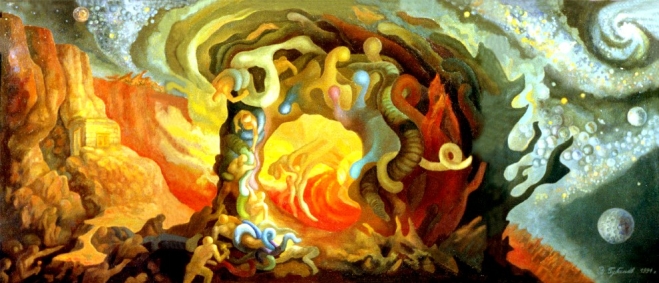Tolstoy said the Doukhobors belonged to the 25th century. He was talking about a group of people who have traditions of refusing to take part in war, refusing to eat or harm animals or put animals to work, engaging in communal sharing of resources and communal approaches to work, gender equality, and letting deeds speak in place of words — not to mention using nudity as a form of nonviolent protest.
You can see how such people might have run into trouble in a Russian empire or the great nation of Canada. One of their most important historical events is the Burning of Arms which happened in 1895 in Georgia. With roots in Ukraine and Russia, with members living in those countries and throughout Eastern Europe, as well as Canada, the Doukhobors might draw attention in this moment of war fever more than the Mennonites, Amish, Quakers, or any of the other communities of people who have struggled to fit into a war-extraction-exploitation-mad society.
Like any other group, the Doukhobors are made up of individuals, who have differed from each other, done heroic things, and done shameful things. Their way of life may have little to offer in the way of sustainability that surpasses the way of life of the people who were displaced in Canada to make room for the Europeans. But there’s little question we’d have a better chance of seeing a 25th century with human life on Earth if we sought more wisdom from 25th century people who’ve been living among us for many years.
Tolstoy was inspired by and inspired the Doukhobors. He sought to live out a life of love and kindness without major systemic contradictions. He saw this in the Doukhobors and helped fund their emigration to Canada. Here’s a new book of biographies of Doukhobors that I was just sent. Here’s an excerpt from a chapter by Ashleigh Androsoff:
“Historically, Doukhobors have made important calls for peace. We value our ancestors participation in the great Burning of Arms event for good reason: this was a definitive moment in Doukhobor history, and a dramatic testament to the participants’ pacifist convictions. Some of our grandparents had opportunities to show similar resolve during the First and Second World Wars by refusing to register for military service, even if it meant working at Alternative Service or facing imprisonment for failure to report. In the 1960s some Doukhobors participated in a series of ‘peace manifestations’ at military installations in Alberta and Saskatchewan. I believe that twenty-first century Doukhobors have much more work to do as peacebuilders. I believe we should not only be participating more actively in peacebuilding, but that we should become more visible as leaders in the peace movement.”
Hear! hear!
Well, I think that EVERYONE should be a bigger part of the peace movement.
And here’s what I think we should do. Invite both NATO and Russia into the Donbas with all of their weapons, to be dumped onto a massive pile.
Burn, baby, burn.


